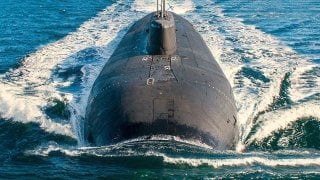Russia Is Looking to Use Nuclear-Powered Subs to Transport LNG
The route, “which runs along Russia’s Arctic shores from Murmansk in the west to the Bering Strait in the east” offers quicker passage than having vessels transit through the North Sea, to the Mediterranean, and through the Suez Canal.
The United States Navy’s Gerald R. Ford-class supercarriers are the largest military warships powered by nuclear propulsion. While the United States has experimented with nuclear power for commercial vessels—notably with the NS Savannah, a merchant vessel built in the 1950s—the technology was never found to be effective, while costing too much.
However, the Soviet Union did develop a small fleet of nuclear-fueled icebreakers, and Russia has continued to operate and produce the vessels, which have proven to be well-suited to their specific role.
Now Russia is looking at using nuclear-powered submarines to transport liquefied natural gas (LNG) via the Northern Sea Route (NSR), Reuters first reported. The route, “which runs along Russia’s Arctic shores from Murmansk in the west to the Bering Strait in the east” offers quicker passage than having vessels transit through the North Sea, to the Mediterranean, and through the Suez Canal.
The aforementioned nuclear-powered ice breakers are already employed in clearing ice for transport through the NSR, but Moscow lacks the vessels that can clear the ice.
Russia’s Arctic LNG 2 is Now Online
Russia is on track to complete the production lines at its Arctic LNG 2 facility by July 2026, allowing Russia to become the world’s largest producer of LNG. It could produce as much as 19.8 million metric tons of LNG annually, which could be sold for billions of dollars to customers in Asia.
Western sanctions imposed in 2022 had delayed but not stopped the efforts—while the bigger issue has been the specially-built vessels that were designed to carry the LNG through the Arctic seas. Due to the sanctions, Novatek—the private company that runs the project—has been unable to close the deal for the vessels. Instead, the producer has been seeking to buy older LNG carriers and operate them in the summer months.
Can’t Go Through the Ice? Go Under It!
Moving the LNG only in warm months will limit how much can be transported, and Russia has explored new options. The LNG could still move through the NSR but instead of having to break the ice, the Kurchatov Institute—Russia’s leading nuclear research facility—has proposed employing nuclear-powered submarines.
“This is about the creation of a fundamentally new class of vessel capable of becoming an alternative to ‘traditional’ gas carriers, which in Arctic conditions are unable to navigate all year-round without icebreaker escort,” the Offshore Marintec Russia 2024 website stated.
It added that the concept for submersible nuclear-powered gas carriers was first proposed in the early 2000s, but the Kurchatov Institute and Gazprom, the Russian majority state-owned multinational energy corporation, are now actually developing such a craft.
Reuters cited the RBC News outlet, which stated that “The submarines would be able to carry around 180,000 tons of LNG, in line with a conventional Arc 7 ice class gas carrier,” and each “would be 360 meters long and no more than 70 meters wide.”
The boats would be powered by RITM-200 nuclear reactors, the same ones that Moscow employs with its newest class of icebreakers.
Could It Be Built? Maybe, but Maybe Not!
Due to sanctions, Russia has struggled with the production of the latest military hardware—notably tanks and aircraft—yet one area where it has made significant progress is in increasing the size of its fleet of submarines which could see four built this year.
The question would be whether Russia could design and then produce such a craft capable of transporting the LNG safely, and then whether Moscow could produce the facilities and train the crews to operate the nuclear-powered tanker submarines.
“My opinion is that people think, ‘Maybe it’ll work.’ But given the situation, it’s unlikely,” Alexander Nikitin, a former Russian Navy officer and nuclear expert at the Vilnius-based Bellona Environment Transparency Center, told Reuters. He further suggested the whole program was a giant “bluff.”
Author Experience and Expertise: Peter Suciu
Peter Suciu is a Michigan-based writer. He has contributed to more than four dozen magazines, newspapers, and websites with over 3,200 published pieces over a twenty-year career in journalism. He regularly writes about military hardware, firearms history, cybersecurity, politics, and international affairs. Peter is also a Contributing Writer for Forbes and Clearance Jobs. You can follow him on Twitter: @PeterSuciu. You can email the author: [email protected].
Image Credit: Creative Commons and/or Shutterstock.

